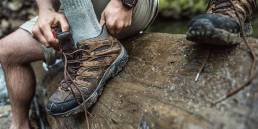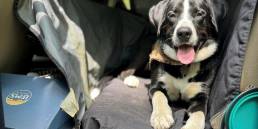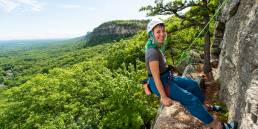I love all-day bike rides. Many times when out in remote areas I’ve dropped pins on my maps to save great campsite locations, just in case. Other times I gaze into the trees along the trail, wondering about the best places to hang a hammock. I was always waiting for the conditions to line up: the weather, the timing, my gear—but I waited for years. Last summer my new boyfriend John and I were discussing shared adventures, and figured out that both of us wanted to try bikepacking. He dusted off his mountain bike and we cobbled together the supplies we’d need. We settled on a route with just one night of camping, to test the waters.

Our Route
Bikepacking.com offers two routes in New Hampshire, the first an 11-day trip that’s over 600 miles long. The other is a 64-mile loop that starts and ends in Gorham, running on the Presidential Rail Trail parallel to Route 2, then circling the Dartmouth Range of mountains, through the Bretton Woods area on a busy road, then over Jefferson Notch, a 3,000-foot summit. As beginners we chose the latter and even cut off a few miles by parking at the rail trail lot rather than in Gorham.
Our Gear
The route passes through inhabited areas that include convenience stores, so we went light on food and drink. We each had a dry sack lashed to our handlebars and rear racks that mounted on our seat posts (for light loads only). In addition, I carried a small backpack with a Camelback (but wish I hadn’t, due to the strain on my shoulders after many miles) and a triangle frame bag with bike tools in it. Lots of bungee cords were needed to secure the loads, and the first hundred yards of travel involved stops to reposition things.
Our Strategy
Before taking off, we divided things up to balance the load between the bikes. We only planned on two days and one night, but it still seemed like a lot of stuff. Keeping the loads low on the bikes was key so it didn’t affect balance or steering. Still, we carried:
- A small water filtration unit,
- Two freeze dried options for dinner and instant oatmeal for breakfast, with plenty of snacks,
- Hydration tablets to replenish electrolytes (it was hot the first week of August),
- Light thermal layers for the evening,
- John’s ultralight tent, a shared quilt, and two sleeping pads,
- Some line for hanging the dry sack/food bag.
For personal hygiene we had moist wipes, toothbrushes and toothpaste, sunscreen, a couple tiny microfiber towels, and the most essential thing for bikers—plenty of chamois cream to ease saddle sores.

Our Experience
Where we would camp was an ongoing debate. The route on Bikepacking.com only offered one option for camping, before the midway point, but on our amended route the halfway point was the developed Bretton Woods village. We made progress faster than expected, so we stopped and enjoyed some skinnydipping in a cool, secluded brook off Old Cherry Mountain Road, the long gravel connection between the Presidential Rail Trail to the north and Route 302 to the south. The road has a 2,000-foot summit that was a long grind up but we were refreshed after soaking in the brook. We considered the first-come campsites on US Forest Service land along that road (which Bikepacking.com suggests) but it was too early in the day.
Route 302 provides opportunities to stop for Gatorade and snacks at convenience stores and restaurants like Fabyan’s Station, near the intersection of Base Station Road. We indulged at a convenience store, then set off again, on Base Station Road’s rolling hills that lead to the Cog Railway and Jefferson Notch. Although there were many vehicles parked along the road here, unloading families going to cool off in the Ammonoosuc River, we kept pushing up into the hills. There are too many crowded condo developments and river visitors to set up camp along that stretch, even though our legs were signaling the end of the day.
We pulled off the road in the National Forest, about a third of the way up Jefferson Notch and past the Cog Railway entrance. At that point the road is dirt and car traffic rare. Our bikes were easily hidden and the mossy forest floor made a soft cushion for our bed. Jefferson Brook, a tributary to the Ammonoosuc, burbled nearby. We had cranked about 35 miles in about 7 hours (with breaks) the first day.
Day two started with the big climb to Jefferson Notch at 3,000 feet, which took about the first two hours. The quiet seasonal road, shaded by thick forest, made it a pleasant experience despite the ascent. We took obligatory photos at the summit then cruised wildly fast for six miles down the other side. There was more vehicle traffic on the north side of the notch because it’s a shorter route to the summit. Soon we were back on the flat Presidential Rail Trail heading toward the car. It was a short day, which allowed for a nice lunch and cool swim in the Ammonoosuc River as a reward.

What I’d Change
Next time I’ll ride something different. I rode my beefy mountain bike with 3-inch (wide) tires, which was overkill on this mostly smooth, gravel and pavement bikepacking route. As much as I loved the granny gear for the two big climbs, the bike was undoubtedly not the most efficient vehicle for this kind of riding. John’s bike is closer to a hybrid with narrower, smoother tires that offered less resistance.
Additionally, I’d ditch the backpack in favor of a bottle with a long straw that I could secure to the handlebars (my frame bag doesn’t allow for a traditional bottle cage).
Starting early in the morning and taking a longer midday break is a good strategy for midsummer bikepacking. We were really hot when in the middle of the route, riding in the blazing sun along 302 near Bretton Woods.
In The Future
I’ve always wanted to do the Continental Divide Trail, which takes a whole summer. It’s not quite time for that yet, so we’ll probably try the 3-day Cross Vermont Trail this summer, and see how it goes.

Alison O'Leary
Alison O’Leary is an avid cross country skier, author, and public speaker. See alisonoleary.com.
Related Posts
April 24, 2024
What to Bring When Road Tripping with Your Dog
Prepare for the ultimate road trip with…




